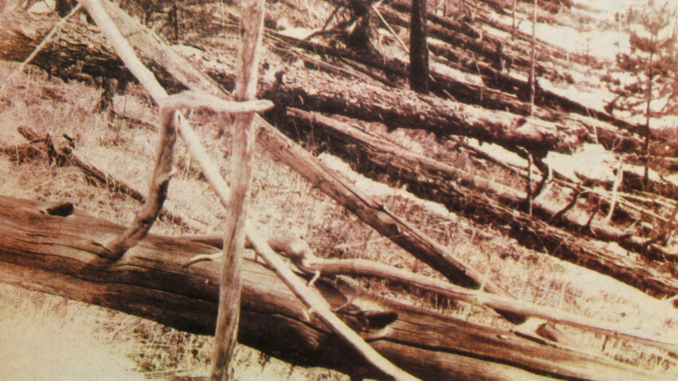
In consideration of the fact that the Tunguska Event has never been covered by the Night Owl, indeed has never even been mentioned in passing in any TNB article, it’s high time we discussed it. Wouldn’t you agree? Good, it’s best not to pretend things never happened.
In brief summation, an explosion occurred in the atmosphere over uninhabited Siberian wilderness on June 30, 1908. (A number of sources state that the date was June 20, but this appears to be either a typo propogated across the internet or a mixup between Gregorian calendar dates and Julian calendar dates which Czarist Russia was still using in 1908). The blast, which has been estimated by multiple investigators to be anywhere from 3 to 30 megatons of TNT (and everywhere in between) leveled more than 2,000 square kilometers (770 square miles) of forest. Trees in the affected area were knocked down in a butterfly pattern, which has been duplicated in small-scale laboratory experiments. Scientists believe the blast was the result of either a comet or meteor entering the atmosphere at a relatively shallow angle approximating 30° relative to the ground.
Various outlying theories have also been suggested to explain the event, including the crash of an alien spaceship and the collision of a small amount of anti-matter with Earth. No evidence has been found to support these theories, however, which has made the Fox Mulders of the world very sad. To spare their feelings, no further mention will be made (in this article, at least) of these far-out musings until at least some supporting evidence is uncovered.
In the 1930s the comet hypothesis was put forward which was supported by the evidence available at the time. Expeditions to the site had found no impact craters or meteorites which strongly suggested that the object had vaporized in the air. Asians, Europeans, and North Americans, had experienced unusual skies for a number of days and nights after the event, including “silvery, glowing clouds, colourful sunsets and a strange nighttime luminescence”, which was thought to be the result of remnant cometary dust and ice in the atmosphere. A Soviet expedition to Tunguska in 1961 only served to solidify the view that a comet was the cause of the event. Another fact that helped the comet theory was the existence of the Beta Taurids meteor shower, which occurs about June 28 – 29 every year. Astronomer Ľubor Kresák proposed in 1978 that Tunguska was caused by a large fragment from Comet Encke, which is the source of the Beta Taurids.
There were proponents of an asteroid/meteor hypothesis as early as 1921, based initially on eyewitness accounts. (A meteor is an asteroid that enters the atmosphere, and a meteorite is what it’s called once it’s on the ground). But, they lacked sufficient hard evidence other than microscopic spheres of magnetite and silicate with a high ratio of nickel over iron, which were found in soil samples in later decades. However, the absence of a meteor impact crater was a major problem for the theory.
There was trouble with the comet theory as well. Many scientists doubted that a comet could reach the low altitude of between 5-10 kilometers (3.1-6.2 miles) where the mid-air explosion occurred, especially given the very shallow entry angle, without completely burning up first. In later decades it was shown that comets disintegrate at much higher altitudes, throwing cold water on the ice ball hypothesis.
In 1999, an Italian expedition to Tunguska looking for meteorite evidence in Lake Cheko found something unexpected; the lake was shaped like a submerged cone rather than having a flat bottom like most lakes, and there was something underneath the bottom of the cone as detected by their seismic instruments.
Lake Checko is only 8 kilometers (5 miles) from the epicenter of the butterfly-shaped event site, and it is along the trajectory of the possible meteoroid so it could potentially be an impact crater. The lake is approximately 500 metres (1,640 ft) long, 300 metres (980 ft) wide, and 50 meters (160 feet) deep.
The Italians returned in 2009 with instruments to conduct a magnetic survey of the lake bottom. They reported finding a magnetic anomaly where the seismic instruments had detected a seismic echo. (Dun, dun, DUN!)
In a 2017 report, Russian researchers who had explored the lake said that they took core samples from the lake that proved the lake was formed hundreds of years ago – nearly two centuries before the Tunguska Event. They concluded the lake could not have been formed by a meteor impact in 1908 because it already existed at that time.
In typical fashion, scientists will continue to go back and forth with evidence and arguments until one theory dominates all others. At the rate this is going, it will be another hundred years before we find out who wins the debate. Until then, the mystery makes it more interesting.
Question of the night: What do you think is at the bottom of Lake Checko?
